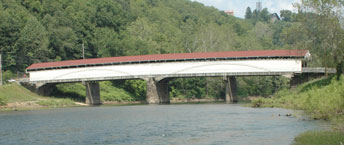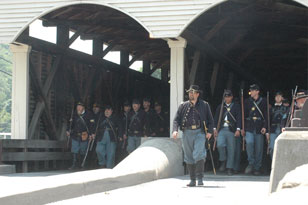 Though extremely versatile, wood has one obvious disadvantage - it burns. In early February 1989, the Philippi Covered Bridge, West Virginian’s oldest covered bridge nearly burned down when the spark of a car set off a stream of gasoline that had run back downhill from the overflow at a local filling station to the bridge, destroying 60 percent of its yellow poplar timbers, siding and roof, particularly on the west span.
Though extremely versatile, wood has one obvious disadvantage - it burns. In early February 1989, the Philippi Covered Bridge, West Virginian’s oldest covered bridge nearly burned down when the spark of a car set off a stream of gasoline that had run back downhill from the overflow at a local filling station to the bridge, destroying 60 percent of its yellow poplar timbers, siding and roof, particularly on the west span.
On September 16, 1991, two years and seven months after fire nearly destroyed it, the Philippi Covered Bridge was returned to service when then Governor Gaston Caperton cut the ribbon officially reopening West Virginia’s premier wooden structure.
According to legend, Lemuel Chenoweth had convinced members of the Virginia Legislature to award him the contract to build the Tygart Valley River span by placing a wooden model of his masterpiece between two chairs and standing on it.
Completed in 1852 by builder Henry Hartley at a cost of just over twelve thousand dollars, the double-barreled 286-foot Long truss continued to serve US 250 traffic through floods and other natural disasters until the accident.
The successful return of the historic span to its original appearance—work that set standards for future renovation of the state’s remaining covered bridges—was the result of a cooperative effort involving the governor, the Division of Highways, West Virginia University, foresters and local restoration fund-raising groups.
An ardent supporter of restoration, Caperton brought the president of the Senate, the speaker of the House and other state officials to the site to almost immediately after the fire to assure local citizens that efforts would be successful.
“Repair whatever we can and replace when we must” was the rule of restoration coordinator Dr. Emory Kemp, WV professor and head of its History of Science and Technology graduate program, who was aided by “meticulous research” by Carl Tiderman of Alderson-Broaddus College in returning the bridge to Chenoweth’s original design, with horizontal siding, a red roof and other touches not previously seen by anyone now living.

Under the watchful eye of Kemp, who had restored other historic spans in West Virginia, Virginia and New England, a 38-man crew was formed, filing with epoxy the pieces of the bridge that remained or shaping and joining new wood using old tools and ancient construction methods such as wooden pegs. Work, done under three supervisors whose former skills included construction, carpentry and cabinet-making, included discovery of nine mine balls first lodged in the beams during the Civil War’s first land battle in 1861.
The yellow poplar needed for restoration, estimated at $100,000, was donated through state Forestry Association Director Dick Waybright, with contributions from the US Forest Service, Westvaco, J.C. Lumber and Allegheny Wood Products.
Located by Georgia-Pacific personnel near Grassy Creek in Nicholas County and Bolair in Webster County, the logs—at least 15 inches in diameter on the small end, with eight required to be 56 feet long and the others from 34 to 44 feet—were harvested by Bess, Harry Vance and Dunsmore Brothers logging companies and loaded onto three tractor-trailers owned by Bennett Logging and Ruckman Trucking for transport to the Belington Industrial Park. There, at a special sawmill set up by Ricotelli Fencing and Ware Lumber, the 56-foot-long 7x10-inch-thing beams were milled by Simpson Lumber Company, with Dingess Lumber manufacturing the structural members shorter than 20 feet.
Under local businessman Fred Crouch, the Philippi Restoration Committee initiated numerous fund-raising projects, including the sale of limited-edition 9x12-inch prints of the bridge by Webster Springs artist James Moran, obtained individual donations totaling $20,000 from throughout the United States, including $500—its largest cash gift—from Lemuel Chenoweth’s granddaughter in Michigan.
Following completion of major restoration efforts, a contract was awarded to install a new deck, sidewalk, handrail system and scour protection for the bridge pier and repoint the stonework. This final step brought the cost of restoration efforts to approximately 265 times the original price to build the span.
The state’s intent to capitalize on what it has learned by putting to further use the skills perfected during restoration efforts were evidence in mid-1990 when Governor Caperton announced an ambitious program, estimated at $3.5 million to restore the state’s 17 remaining covered bridges.